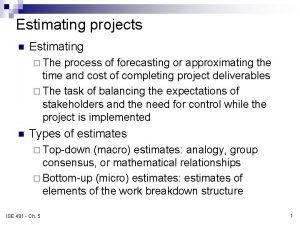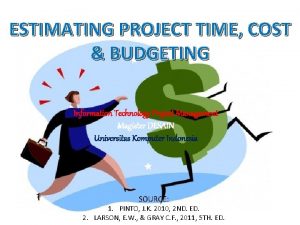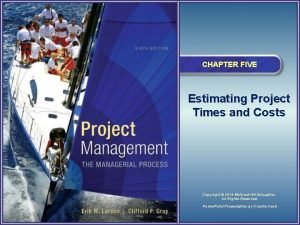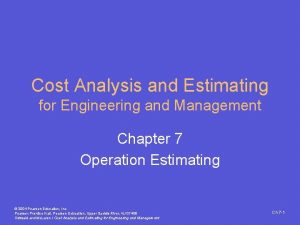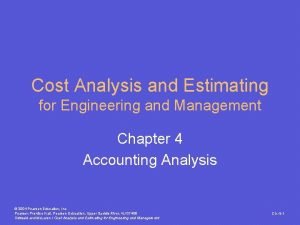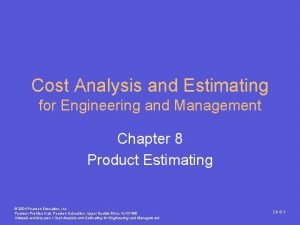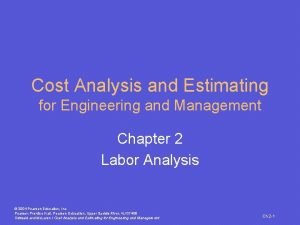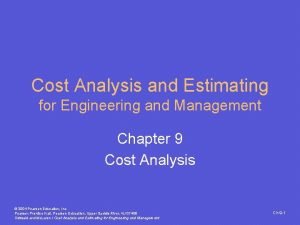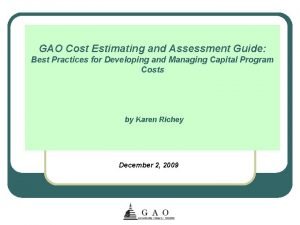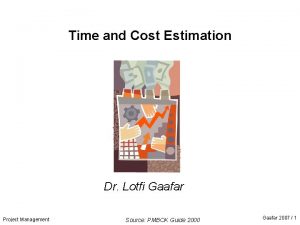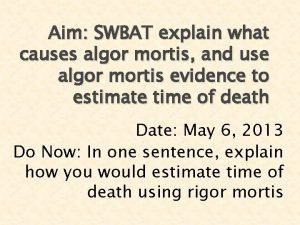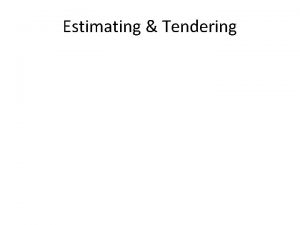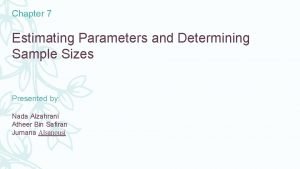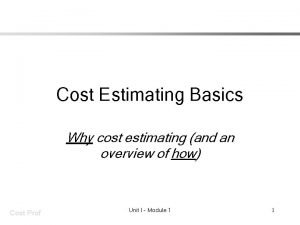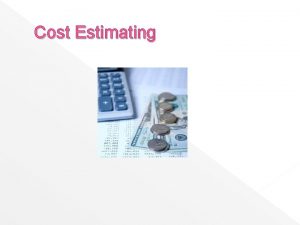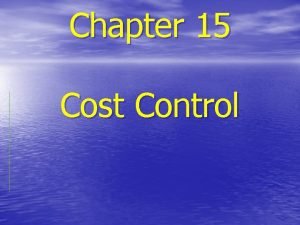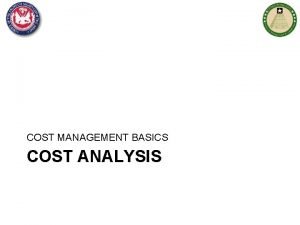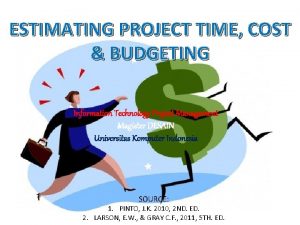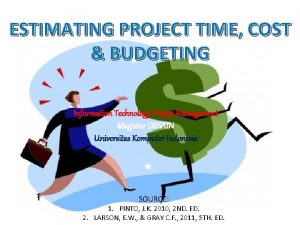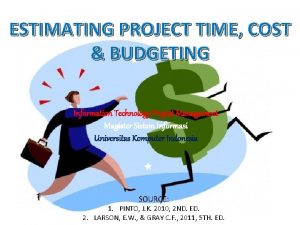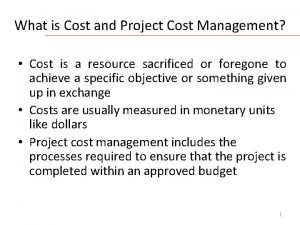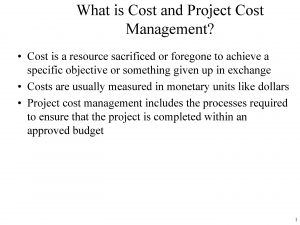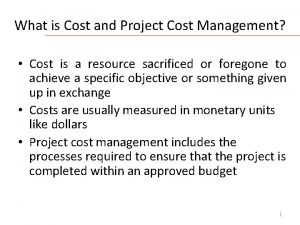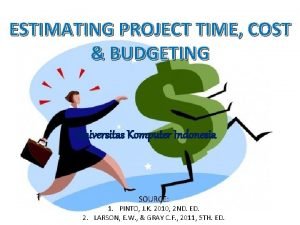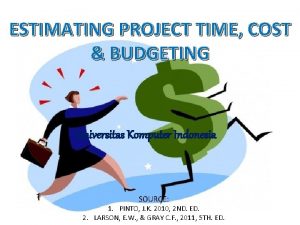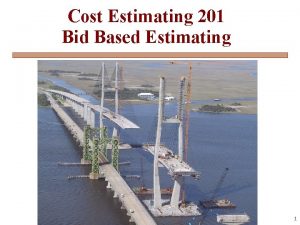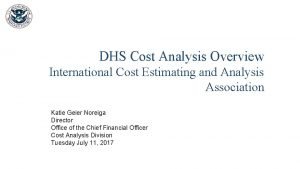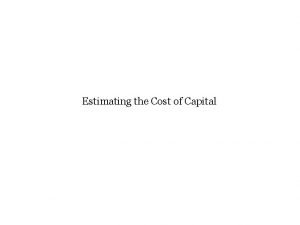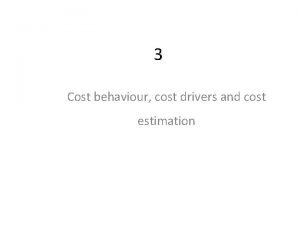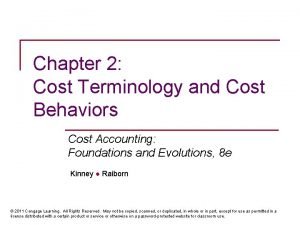Estimating Project Time and Cost 5 1 Estimating











































- Slides: 43

Estimating Project Time and Cost 5– 1

Estimating Projects • Estimating – The process of forecasting or approximating the time and cost of completing project deliverables. – The task of balancing expectations of stakeholders and need for control while the project is implemented. – All project stakeholders prefer accurate cost and time estimates, but they also understand the inherent uncertainty in all projects. – Inaccurate estimates lead to false expectations and consumer dissatisfaction. – Cost, time, and budget estimates are the lifeline for control; they serve as the standard for comparison of actual and plan throughout the life of the project. – Project status reports depend on reliable estimates as the major input for measuring variances and taking corrective action. 5– 2

Estimating Projects - Types • Types of Estimates – Top-down (macro) estimates: are usually done by senior management and will often derived from analogy, group consensus, or mathematical relationships. – Bottom-up (micro) estimates: are typically performed by the people who are doing the work. Their estimates are based on estimates of elements found in the work breakdown structure. 5– 3

Why Estimating Time and Cost Are Important • To support good decisions. • To schedule work. • To determine how long the project should take and its cost. • To determine whether the project is worth doing. • To develop cash flow needs. • To determine how well the project is progressing. • To develop time-phased budgets and establish the project baseline. EXHIBIT 5. 1 5– 4

Quality of Estimates • A typical statement in the field is the desire to “have a 95 percent probability of meeting time and cost estimates. • Past experience is a good starting point for developing time and cost estimates. • Past experience estimates must almost always be refined by other considerations to reach the 95 percent probability level. • Factors related to the uniqueness of the project will have a strong influence on the accuracy of estimates. • Project, people, and external factors all need to be considered to improve quality of estimates for project times and costs. 5– 5

Factors Influencing the Quality of Estimates Planning Horizon Other (Nonproject) Factors Organization Culture Padding Estimates Project Duration Quality of Estimates People Project Structure and Organization 5– 6

Factors Influencing the Quality of Estimates 1. Planning Horizon • The quality of the estimate depends on the planning horizon; estimates of current events are close to 100 percent accurate but are reduced for more distant events. • The accuracy of time and cost estimates should improve as you move from the conceptual phase to the point where individual work packages are defined. 2. Project Duration • Time to implement new technology has a habit of expanding in an increasing, nonlinear fashion. • Sometimes poorly written scope specifications for new technology result in errors in estimating times and costs. • Long-duration projects increase the uncertainty in estimates. 5– 7

Factors Influencing the Quality of Estimates 3. People • • Accuracy of estimates depends on the skills of the people making the estimates. Similarly, whether members of the project team have worked together before on similar projects will influence the time it takes to coalesce into an effective team. People do not focus on a task with 100% efficiency. The difference between “calendar time” and effort must be considered. It should be noted that adding new people to a project increases time spent communicating. 4. Project Structure and Organization • • Which project structure is chosen to manage the project will influence time and cost estimates. The advantage of dedicated project team is the speed gained from concentrated focus and localized project decisions. This speed comes at an additional cost of tying up personnel full time. 5– 8

Factors Influencing the Quality of Estimates 5. Padding Estimates • People may increase estimates to take into account unknown risks and this may force an unnecessary tradeoff. • This phenomenon causes some managers or owners to call for a 10– 15 percent cut in time and/or cost for the project. • Clearly such games defeat chances for realistic estimates, which is what is needed to be competitive. 5– 9

Factors Influencing the Quality of Estimates 6. Organization Culture • What is deemed acceptable behavior by the organization (e. g. padding vs. accuracy) will affect estimates. • In some organizations padding estimates is tolerated and even privately encouraged. • Some organizations place a premium on accuracy and strongly discourage estimating gamesmanship. • The prevailing belief in some organizations is that detailed estimating takes too much time and is not worth the effort or that it’s impossible to predict the future. • Other organizations subscribe to the belief that accurate estimates are the bedrock of effective project management. 5– 10

Factors Influencing the Quality of Estimates 7. Other Factors • Non-project factors can impact time and cost estimates. For example, equipment down-time can alter time estimates. • National holidays, vacations, and legal limits can influence project estimates. • Project priority can influence resource assignment and impact time and cost. 5– 11

Estimating Guidelines for Times, Costs, and Resources 1. Responsibility - Have people familiar with the tasks make the estimate. – These people will not have some preconceived, imposed duration for a deliverable in mind. They will give an estimate based on experience and best judgment. – A secondary benefit of using those responsible is the hope they will “buy in” to seeing that the estimaterializes when they implement the work package. – Easier to hold them responsible for failure to achieve the estimated time. – Finally, drawing on the expertise of team members who will be responsible helps to build communication channels early. 5– 12

Estimating Guidelines for Times, Costs, and Resources 2. Use several people to make estimates. – It is well known that a cost or time estimate usually has a better chance of being reasonable and realistic when several people with relevant experience and/or knowledge of the task are used. – True, people bring different biases based on their experience. – But discussion of the individual differences in their estimate leads to consensus and tends to eliminate extreme estimate errors. 3. Base estimates on normal conditions, efficient methods, and a normal level of resources. – If the normal workday is eight hours, the time estimate should be based on an eight-hour day. – Similarly, if the normal workday is two shifts, the time estimate should be based on a two-shift workday. 5– 13

Estimating Guidelines for Times, Costs, and Resources 4. Use consistent time units in estimating task times. – Estimates of time must consider normal time: calendar days, workweeks, person days, single shift, hours, minutes, etc. 5. Treat each task as independent, don’t aggregate. – Use of first-line managers usually results in considering tasks independently. 6. Don’t make allowances for contingencies in work package estimates. – The estimate should assume normal or average conditions even though every work package will not materialize as planned. – For this reason top management needs to create an extra fund for contingencies that can be used to cover unforeseen events. 5– 14

Estimating Guidelines for Times, Costs, and Resources 7. Adding a risk assessment helps avoid surprises to stakeholders. – It is obvious some tasks carry more time and cost risks than others. For example, a new technology. – Simply identifying the degree of risk lets stakeholders consider alternative methods and alter process decisions. 5– 15

Top-Down versus Bottom-Up Estimating • Top-Down (macro) Estimates – Can provide a quick but rough estimate. – Are usually are derived from someone who uses experience and/or information to determine the project duration and total cost. – Are made by top managers who have little knowledge of the processes used to complete the project. – Usually occurs during conception stage when a full design and WBS are not available – Can be highly inaccurate 5– 16

Top-Down versus Bottom-Up Estimating • Bottom-Up (micro) Approach – can provide a fairly accurate estimate, but is time consuming. – Can serve as a check on cost elements in the WBS by rolling up the work packages and associated cost accounts to major deliverables at the work package level. – May require multiple personnel and time to complete – If done properly, a bottom-up estimate can yield accurate cost and time estimates. 5– 17

Top-Down versus Bottom-Up Estimating Conditions for Preferring Top-Down or Bottom-up Time and Cost Estimates Condition Strategic decision making Macro Estimates Micro Estimates X Cost and time important X High uncertainty X Internal, small project X Fixed-price contract X Customer wants details X Unstable scope X TABLE 5. 1 5– 18

Top-Down versus Bottom-Up Estimating • Top-down estimates usually are derived from someone who uses experience and/or information to determine the project duration and total cost. • These estimates are sometimes made by top managers who have very little knowledge of the processes used to complete the project. • Push the estimating process down to the work package level for bottom-up estimates that establish low-cost, efficient methods. • This process can take place after the project has been defined in detail. • The bottom-up approach at the work package level can serve as a check on cost elements in the WBS by rolling up the work packages and associated cost accounts to major deliverables. • Similarly, resource requirements can be checked. 5– 19

Estimating Projects: Preferred Approach • Make rough top-down estimates. • Develop the WBS/OBS. • Make bottom-up estimates. • Develop schedules and budgets. • Reconcile differences between top-down and bottom-up estimates In conclusion, the ideal approach is for the project manager to allow enough time for both the top-down and bottom-up estimates to be worked out so a complete plan based on reliable estimates can be offered to the customer. 5– 20

Top-Down Approaches for Estimating Project Times and Costs • Consensus methods • Ratio methods • Apportion method • Function point methods for software and system projects Project Estimate Times Costs • Learning curves 5– 21

Top-Down Approaches – Consensus Method • This method simply uses the pooled experience of senior and/or middle managers to estimate the total project duration and cost. • This typically involves a meeting where experts discuss, argue, and ultimately reach a decision as to their best guess estimate. • It is important to recognize that these first top-down estimates are only a rough cut and typically occur in the “conceptual” stage of the project. • At this level individual work items are not identified. • Nevertheless, the initial top-down estimates are helpful in determining whether the project warrants more formal planning, which would include more detailed estimates. 5– 22

Top-Down Approaches – Ratio Method • Top-down methods (sometimes called parametric) usually use ratios, or surrogates, to estimate project times or costs. • Top-down approaches are often used in the concept or “need” phase of a project to get an initial duration and cost estimate for the project. For example, contractors frequently use number of square feet to estimate the cost and time to build a house; that is, a house of 2, 700 square feet might cost $160 per square foot (2, 700 feet * $160 per foot equals $432, 000). 5– 23

Top-Down Approaches – Apportion Method • This method is an extension to the ratio method. • Apportionment is used when projects closely follow past projects in features and costs. • Given good historical data, estimates can be made quickly with little effort and reasonable accuracy. • This method is very common in projects that are relatively standard but have some small variation or customization. Example: Given an estimated total cost for the house, pay to the contractor can be authorized by completion of specific segments of the house: foundation might represent 3 percent of the total loan, framing 25 percent, electric, plumbing and heating 15 percent, etc. Payments are made as these items are completed. 5– 24

Apportion Method of Allocating Project Costs Using the Work Breakdown Structure FIGURE 5. 1 5– 25

Top-Down Approaches Function Point Methods for Software and System Projects Learning Curves Canceled 5– 26

Bottom-Up Approaches for Estimating Project Times and Costs • Template methods • Parametric procedures applied to specific tasks • Range estimates for the WBS work packages • Phase estimating: A hybrid 5– 27

Bottom-Up Approaches (Template Methods) • If the project is similar to past projects, the costs from past projects can be used as a starting point for the new project. • Differences from the appropriate standardized project are noted (for times, costs, and resources) and changes are made. • This approach enables the firm to develop a potential schedule, estimate costs, and develop a budget in a very short time span. 5– 28

Bottom-Up Approaches (Parametric Procedures Applied to Specific Tasks) • Just as parametric techniques such as cost per square foot can be the source of top-down estimates, the same technique can be applied to specific tasks. – For example, as part of an MS Office conversion project, 36 different computer workstations needed to be converted. Based on past conversion projects, the project manager determined that on average one person could convert three workstations per day. Therefore the task of converting the 36 workstations would take three technicians four days [(36/3)/3]. 5– 29

Bottom-Up Approaches (Range Estimating) • Range estimating works best when work packages have significant uncertainty associated with the time or cost to complete. • If the work package is routine and carries little uncertainty, using a person most familiar with the work package is usually the best approach. They know from experience or know where to find the information to estimate work package durations and costs. • However, when work packages have significant uncertainty associated with the time or cost to complete, it is a prudent policy to require three time estimates—low, average, and high. • Determining the low and high estimates for the activity is influenced by factors such as complexity, technology, newness, familiarity. • A group determine the low, average, and high cost or duration gives best results. Group estimating tends to refine extremes by bringing more evaluative judgments to the estimate and potential risks. 5– 30

Support Cost Estimate Worksheet FIGURE 5. 2 5– 31

A Hybrid: Phase Estimating • This approach begins with a top-down estimate for the project and then refines estimates for phases of the project as it is implemented. • Some projects by their nature cannot be rigorously defined because of the uncertainty of design or the final product. • Phase estimating is used when an unusual amount of uncertainty surrounds a project and it is impractical to estimate times and costs for the entire project. • Phase estimating uses a two-estimate system over the life of the project. A detailed estimate is developed for the immediate phase and a macro estimate is made for the remaining phases of the project. • Phase estimating is preferred by those working on projects where the final product is not known and the uncertainty is very large. • A major advantage for the customer is the opportunity to change features, re-evaluate, or even cancel the project in each new phase. 5– 32

Phase Estimating over Product Life Cycle FIGURE 5. 3 5– 33

Top-Down and Bottom-Up Estimates FIGURE 5. 4 5– 34

Level of Detail • Level of detail is different for different levels of management. – Top management interests usually center on the total project and major milestone events that mark major accomplishments. – Middle management might center on one segment of the project or one milestone. – First-line managers’ interests may be limited to one task or work package. – One of the beauties of WBS is the ability to aggregate network information so each level of management can have the kind of information necessary to make decisions. 5– 35

Level of Detail • Level of detail in the WBS varies with the complexity of the project; the need for control; the project size, cost, duration; and other factors. • Excessive detail is costly. – Fosters a focus on departmental outcomes. – Creates unproductive paperwork. • Insufficient detail is costly. – Lack of focus on goals – Wasted effort on nonessential activities 5– 36

Types of Costs • Direct Costs – Costs that are clearly chargeable to a specific work package (Labor, materials, equipment, and other) – These costs represent real cash outflows and must be paid as the project progresses. • Direct (Project) Overhead Costs – Direct overhead rates more closely pinpoint which resources of the organization are being used in the project. – Costs incurred that are directly tied to an identifiable project deliverable or work package (Salary of the project manager, rental of space for project team) – Although overhead is not an immediate out-of-pocket expense, it is real and must be covered in the long run if the firm is to remain viable. 5– 37

Types of Costs • General and Administrative Overhead Costs – Organization costs indirectly linked to a specific package that are apportioned to the project. – These costs are carried for the duration of the project. – Examples include organization costs across all products and projects such as advertising, accounting, and senior management above the project level. 5– 38

Contract Bid Summary Costs Direct costs Direct overhead Total direct costs G&A overhead (20%) $80, 000 $20, 000 $100, 000 $20, 000 Total costs Profit (20%) Total bid $120, 000 $24, 000 $144, 000 FIGURE 5. 5 5– 39

Refining Estimates • Experience tells us that for many projects the total estimates do not materialize and the actual costs and schedule of some projects significantly exceed original work package–based estimates. • In order to compensate for the problem of actual cost and schedule exceeding estimates, some project managers adjust total costs by some multiplier (i. e. , total estimated costs 3 1. 20). • There a number of reasons for this, most of which can be traced to the estimating process and the inherent uncertainty of predicting the future. 5– 40

Refining Estimates • Reasons for Adjusting Estimates – Interaction costs are hidden in estimates. • Tasks are rarely completed in a vacuum. • Work on one task is dependent upon prior tasks, and the handoffs between tasks require time and attention. • The time necessary to coordinate activities is typically not reflected in independent estimates. • Coordination is reflected in meetings and briefings as well as time necessary to resolve disconnects between tasks. – Normal conditions do not apply. • Resource shortages, whether in the form of people, equipment, or materials, can extend original estimates. • Outsourcing certain tasks can increase costs as well as extend task durations since time is added to acclimating outsiders to the particulars of the project and the culture of the organization. 5– 41

Refining Estimates • Reasons for Adjusting Estimates – Things go wrong on projects. • Design flaws are revealed after the fact, extreme weather conditions occur, accidents happen, and so forth. – Changes in project scope and plans. • As one gets further and further into the project, a manager obtains a better understanding of what needs to be done to accomplish the project. This may lead to major changes in project plans and costs. • Likewise, if the project is a commercial project, changes often have to be made midstream to respond to new demands by the customer and/or competition. 5– 42

Refining Estimates • Adjusting Estimates – Time and cost estimates of specific activities are adjusted as the risks, resources, and situation particulars become more clearly defined. – Effective organizations recognize that the rolled up estimates generated from a detailed estimate based on the WBS are just the starting point. – They factor the final assignment of resources into the project budget and schedule (i. e. not enough bulldozers). – They adjust estimates to account for specific actions to mitigate potential risks on the project (i. e. independent testers of the system). – Organizations adjust estimates to take into account abnormal conditions. (i. e. soil problems) 5– 43
 Estimating project time and cost
Estimating project time and cost Top down budgeting vs bottom up budgeting
Top down budgeting vs bottom up budgeting Estimating project time and cost
Estimating project time and cost Cost analysis and estimating for engineering and management
Cost analysis and estimating for engineering and management Cost analysis and estimating for engineering and management
Cost analysis and estimating for engineering and management Cost analysis and estimating for engineering and management
Cost analysis and estimating for engineering and management Cost analysis and estimating for engineering and management
Cost analysis and estimating for engineering and management Cost analysis and estimating for engineering and management
Cost analysis and estimating for engineering and management Cost control and cost reduction project report
Cost control and cost reduction project report Cost control and cost reduction project report
Cost control and cost reduction project report Gao cost estimating and assessment guide 2020
Gao cost estimating and assessment guide 2020 Mcaces
Mcaces Project crashing example
Project crashing example Lotfi gaafar
Lotfi gaafar What is elapsed time
What is elapsed time Algor mortis practice problems
Algor mortis practice problems Cost accumulation and cost assignment
Cost accumulation and cost assignment Cost accumulation and cost assignment
Cost accumulation and cost assignment Cost accumulation and cost assignment
Cost accumulation and cost assignment What is a period cost on the income statement
What is a period cost on the income statement Dennis geyer
Dennis geyer What is standard costing
What is standard costing Distinguish between average cost and marginal cost
Distinguish between average cost and marginal cost Cost control and cost reduction difference
Cost control and cost reduction difference Job order cost system
Job order cost system Ordering cost and carrying cost
Ordering cost and carrying cost Difference between opportunity cost and trade off
Difference between opportunity cost and trade off Cost structure refers to the relative proportion of
Cost structure refers to the relative proportion of Manufacturing cost vs non manufacturing cost
Manufacturing cost vs non manufacturing cost Job order costing vs process costing
Job order costing vs process costing Whats financial leverage
Whats financial leverage Controllable costs
Controllable costs Manufacturing cost vs non manufacturing cost
Manufacturing cost vs non manufacturing cost The formula for usage variance is (aq - sq) * sp.
The formula for usage variance is (aq - sq) * sp. Flotation cost in cost of equity
Flotation cost in cost of equity Literal cost gate input cost
Literal cost gate input cost Literal cost gate input cost
Literal cost gate input cost Literal cost gate input cost
Literal cost gate input cost Front-end rounding
Front-end rounding Tendering and estimating
Tendering and estimating Batten wiring diagram
Batten wiring diagram What is the point estimate of μ?
What is the point estimate of μ? Agile estimating and planning
Agile estimating and planning Estimating sums and differences of decimals
Estimating sums and differences of decimals
